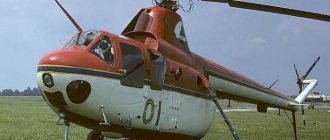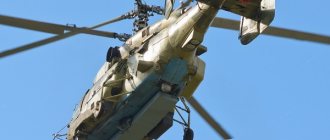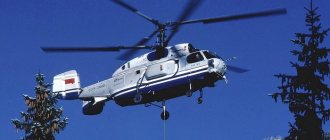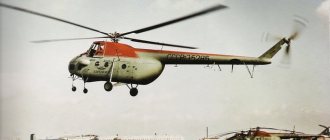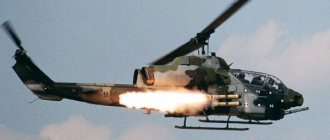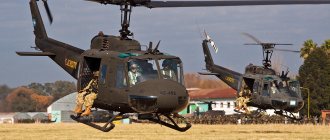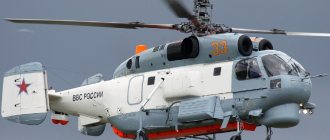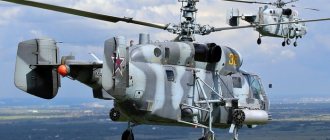This article is about the transport helicopter. For the British Secret Intelligence Service (MI6), see Secret Intelligence Service.
| Mi-6 | |
| Mi-6 at Tempelhof Open Day 1992 | |
| Type | multi-role helicopter |
| Developer | OKB M. L. Mil |
| Manufacturer | Plant No. 23 Plant No. 168 |
| Chief designer | M. L. Mil |
| First flight | June 18, 1957[1] |
| Start of operation | 1963 |
| End of operation | 2002 (Russia) [2][not in the source ] |
| Operators | USSR (former) see operators |
| Years of production | 1959—1980[1] |
| Units produced | 926[1][3] |
| Options | Mi-10 |
| Media files on Wikimedia Commons | |
Mi-6
Mi-6
(according to NATO classification:
Hook
)
is a Soviet heavy multi-purpose helicopter. Created in the second half of the 1950s, when the USSR adopted Luna mobile missile systems, the transfer of which required a heavy-duty helicopter.
The first flight took place on June 5, 1957. State tests took place in 1959-1963. It was built since 1959 at the Rostov Helicopter Plant, in both military and civilian versions. Mi-6 is the world's first mass-produced helicopter equipped with two turboshaft engines with a free turbine; its layout scheme is recognized as classical[4]. The Mi-6 was the most lifting helicopter of its time.
In 1964-1978 it was exported[4].
Development history
At the end of 1952, the Mil Design Bureau began research on the creation of a heavy transport helicopter.[3]
On June 11, 1954, the Mil Design Bureau received a Resolution of the Council of Ministers on the development of a heavy transport helicopter. In accordance with it, a heavy helicopter had to carry 6 tons of cargo at normal take-off weight, 8 tons at overload and 11.5 tons in the case of a short flight [1].
Mil OKB began developing the helicopter simultaneously in transport, landing and ambulance versions. For the first time in the USSR, a helicopter provided for the transportation of cargo on an external sling.
The main competitor of the future Mi-6 was supposed to be the Ka-22, developed at the N. I. Kamov Design Bureau. Unlike the Mi-6, the Ka-22 was built according to a transverse design with two rotors of relatively small diameter, which, as it turned out later, was not economically feasible[1].
Ka 27 anti-submarine helicopter project - birth and construction of the machine
After the meeting of the State Commission, the main focus in the work on the project was the propulsion system of the future machine. The bet was placed on gas turbine engines, which, unlike their piston counterparts, had greater power and a long service life. Thanks to the installation of new engines, the vehicle's carrying capacity increased and its range of action increased. With such characteristics, the helicopter became not only a search engine and target designator, but could also perform strike functions.
The first prototype, designated Ka-252, took off in August 1973. In the military-technical nomenclature of Soviet aviation equipment, the helicopter received the designation Ka-27. In the West, the new Soviet helicopter was immediately given the code “Helix,” literally “Spiral.” It should be noted that the completion of work on the creation of a new helicopter for the needs of the USSR Navy was carried out by S.V. Mikheev. Nikolai Ilyich Kamov died in November 1973, before his brainchild went into production.
Despite the fact that the new helicopter turned out to be an order of magnitude better than its predecessor, work was carried out for another three long years to improve the design of the machine. Two versions of the helicopter were created at once:
- search and rescue helicopter Ka-27PS (item 500);
- anti-submarine rotorcraft Ka-27PL (product 501).
Only in 1977, it was decided to begin mass production of the aircraft at the Kumertau Aviation Production Enterprise, located in the Bashkir city of Kumertau. The first production vehicles to roll off the assembly line were the heavy aircraft-carrying cruiser Minsk. On this ship, a detachment consisting of five Ka-27PL helicopters carried out trial operation. In addition to them, a helicopter regiment was formed in the Northern Fleet, where new vehicles were tested and tested before entering the ships. The fact that mass production officially began in 1977, the new helicopter began to be delivered en masse to the fleet only in the spring of 1981. Again, three years were spent linking all the procedural and technical issues related to the manufacturability of the helicopter production and the refinement of the main components and assemblies of the rotorcraft.
Production
Serial production of the Mi-6 was launched simultaneously at two enterprises: Moscow plant No. 23 and Rostov plant No. 168[1].
In 1959, the first 4 serial Mi-6s were produced at the Rostov plant No. 168. The production of the Mi-6 in Rostov continued until 1980, when it was replaced by the Mi-26. From 1959 to 1980, the company produced 874 Mi-6s[1].
Only 50 Mi-6s were produced in Moscow between 1960 and 1962, due to the plant’s transition to producing rocket and space technology.
A total of 926 helicopters were produced.
Flight performance
Tyumen region, filming of the film “On Earth and in the Sky” commissioned by the Rostov Helicopter Plant. Swashplate
| The section lacks links to sources. Information must be verifiable or it may be deleted. You can edit the article to add links to authoritative sources. This mark was set on July 10, 2011 . |
- Engine (quantity, type, brand) 2 x GTE D-25V
- Cabin load, kg: 12,000
- Suspension load, kg: 8000
- Max. speed, km/h: 250/340
- Cruising speed, km/h: 200/250
- Stat. ceiling, m: 2250
- Practical range, km: 1450
- Range, km: 620—1000
- Flight duration, hours: less than 3
Fuselage dimensions
- Length, m: 33.16
- Height, m: 9.16
- Width, m: 3.2
Cabin dimensions
- Length, m: 12
- Height, m: 2.65
- Width, m: 2.5
- NV diameter, m: 35
Modifications
| Model name | Brief characteristics, differences |
| Mi-6A | A new basic modification of the helicopter, created in 1971 as a result of numerous modifications |
| Mi-6ATZ | Tanker based on the Mi-6A transport helicopter |
| Mi-6VKP | Air command post. |
| Mi-6M | Basic anti-submarine helicopter, work on which began in 1958. |
| Mi-6P | Passenger modification of the helicopter (Salon), created in 1965. |
| Mi-6PZh | Fire option. |
| Mi-6PP | Jammer for radio reconnaissance and detection systems of the AWACS type. Not mass-produced. |
| Mi-6PRTBV | Helicopter-type mobile missile and technical base. |
| Mi-6PS | Search and rescue helicopter. |
| Mi-6RVK | Rocket and helicopter complex. |
| Mi-6TZ | Fuel tanker for ground forces and aviation. |
| Mi-22 (Mi-6AYA) | Air command post. |
Summing up
Over the years of serial production, a small number of KA-27 vehicles were produced. The bulk of production vehicles is represented by the anti-submarine version of the Ka-27PL. An order of magnitude fewer search and rescue helicopters of this model were produced. The helicopter was delivered abroad. This car is well known in Egypt and Syria. The navies of Vietnam, China and India are equipped with Soviet helicopters.
A number of vehicles are currently being equipped by the Ukrainian Navy.
For the Russian Navy, the Ka-27PL anti-submarine helicopters are currently the main machine. They are used as part of the aviation group of the heavy aircraft-carrying cruiser Admiral Fleet Kuznetsov. Before new vehicles enter the fleet, it is planned to carry out a complete modernization of the existing Ka-27 combat helicopters in the fleet. The estimated number of vehicles to be modernized is 45-50 units. Innovations and modifications will mainly affect the sonar equipment of helicopters. The vehicles will be equipped with new long-range search and detection systems for submarines of all types, which will significantly increase the combat suitability of helicopters of this type.
It is assumed that the old Ka-27PL will soon be replaced by their modern counterparts, the Ka-50 and Ka-52 helicopters.
World records
In 1961, the Mi-6 became the first machine in the world to overcome a speed of 300 km/h, which was considered the maximum speed for helicopters at that time[1]. In total, the Mi-6 helicopter set 16 world records[3][4].
| Record date | Helicopter crew | Description |
| October 30, 1957[3] | Piloted by: R. I. Kaprelyan Co-pilot: German G. V. Flight technician: F. S. Novikov | In one flight, two records : a load weighing 12,000 kg was lifted to a height of 2432 m and a flight altitude record was set at 2432 m with a load weighing more than 10 tons. |
| April 16, 1958[3] | Piloted by: S. G. Brovtsev Co-pilot: P. I. Shishov Flight engineer: V. F. Konovalov | A lifting capacity record was set: a load weighing 5000 kg was lifted to a height of 5584 m. |
| April 16, 1958[3] | Piloted by: R. I. Kaprelyan Second pilot: N. V. Leshin | A lifting capacity record was set: a load weighing 10,000 kg was lifted to a height of 4885 m. |
| September 21, 1959[3] | Piloted by: B.V. Zemskov Second pilot: P.I. Shishov Navigator: S.I. Klepikov Flight engineer: S.G. Bugaenko | A flight speed record of 268.92 km/h was set on a closed 100-km route (Tushino - Istra - Golitsyno - Tushino). |
| September 21, 1961[3] | Piloted by: N.V. Leshin Co-pilot: V.P. Koloshenko Flight engineer: F.S. Novikov | A flight speed record of 320 km/h was set, which was 10 km/h higher than the record of the American S-61 helicopter, set on May 17, 1961. |
| September 11, 1962[3] | Piloted by: V.P. Koloshenko Co-pilot: G.R. Karapetyan Navigator: S.I. Klepikov Flight engineer: V.I. Shcherbinin Flight operator S.I. Ivanov | In one flight, four records were set: a flight speed of 284.534 km/h along a closed 1000 km route with a load of 1000, 2000 and 5000 kg, as well as a flight speed of 294 km/h along a 500 km route. |
| September 13, 1962[3] | Piloted by: R.I. Kaprelyan Co-pilot: N.V. Leshin Flight engineer: S.I. Bugaenko Leading flight test engineer: V.S. Otdelentsev | Three records were set in one flight : flight altitude of 2738 m with a load of 15,000 kg and 20,000 kg, and lifting a maximum load of 20,117 kg to a height of 2000 m. |
| September 15, 1962[3] | Piloted by: B.K. Galitsky Co-pilot: V. Kozyrev Navigator: M. Kharitonov Flight engineer: K. Matveev Flight operator: S. Rybalko Leading engineer: Yu. Konsheev | In one flight, four records : a flight speed of 300.377 km/h was achieved along a closed 1000-km route with a load of 1000 and 2000 kg, and then a flight speed of 315.657 km/h along a closed 500-km route. |
| August 26, 1964[3] | Piloted by: B.K. Galitsky Co-pilot: n/a Navigator: n/a Flight engineer: n/a | A flight speed record of 340.15 km/h was set on a closed route of 100 km. |
Details of the MI-2 helicopter crash today, December 27, 2021
Today, December 27, 2022, the Shot Telegram channel reported that an MI-2 helicopter crashed on the territory of the Republic of Udmurtia. The information was confirmed by the Chairman of the Government of the Republic Yaroslav Semenov. According to him, the crew themselves managed to report the incident to service 112. The emergency occurred around 14:15 Moscow time.
The crew was patrolling main oil pipelines. Three emergency medical teams arrived at the scene of the emergency.
Cause of the plane crash, who owned the helicopter
At this time, the cause of the helicopter crash is unknown. The Investigative Committee reported that the circumstances of the incident are being clarified. It is known that the aircraft belongs to the Kazan Aviation Enterprise; at 11:00 Moscow time, the helicopter took off from the Izhevsk airfield and flew over the oil pipeline.
Operators
Current
- Uzbekistan - 26 Mi-6 units and 2 Mi-22 units (Mi-6AYA), as of 2016[5]
- Laos - one Mi-6 unit as of 2016[6]
Former military
- USSR
- Algeria - 4 - 5 Mi-6T units delivered from the USSR in 1972[7]
- Belarus - several Mi-6 units as of 2013
- Vietnam - 10 Mi-6T units delivered from the USSR in 1966 and 1970[7]
- Egypt - 19 Mi-6T units were supplied from the USSR in 1965 and 1971[7]
- Indonesia - 8 Mi-6T units delivered from the USSR in 1965[7]
- Iraq - from 10 to 13 Mi-6T units delivered from the USSR in 1973[7]
- Pakistan - 1 Mi-6T unit delivered from the USSR in 1968[7]
- Peru - from 6 to 16 Mi-6T units were delivered from the USSR in the period from 1971 to 1972[7]
- Poland - 3 Mi-6s were in service with the Polish Armed Forces in 1986-1990; 2 helicopters were sold to Ukraine and 1 was transferred to the aviation museum[8]
- Russia - 10 Mi-6 units as of 2013[9]
- Syria - 10 Mi-6T units were supplied from the USSR between 1972 and 1973[7]
- Ethiopia - from 4 to 10 Mi-6T units delivered from the USSR in 1978[7]
Civil
- USSR
- Poland - 3 Mi-6A were operated in 1974-1985 [ source not specified 2735 days
]
Aircraft accidents and disasters
| The section lacks links to sources. Information must be verifiable or it may be deleted. You can edit the article to add links to authoritative sources. This mark was set on October 24, 2011 . |
| date | Board number | Disaster site | Deaths/total on board | Short description |
| 29.12.1962 | n.d. | Torzhok | 3/7 | Test flight. At an altitude of 3000 meters, an oil leak began from the gearbox, which escalated into a fire. 4 crew members escaped with parachutes. |
| 02.07.1967 | 11289 | Surgut | 9+0/5 | Collided with An-2. Made a safe landing, the An-2 crashed. |
| 06.08.1967 | 06174 | near Marseille | 9/9 | While extinguishing a forest fire on a Mi-6 helicopter, the outstanding Soviet test pilot Yu. A. Garnaev died. |
| 01.05.1968 | n.d. | Gilgit | n.d. | Crashed during a demonstration flight for the Pakistan Air Force, killing the crew. |
| 16.10.1969 | 21192 | Komi Autonomous Soviet Socialist Republic pl-ka Lenavozh-3 | 5/10 | The main cause of the flight accident was the destruction of the main rotor blades from an impact with the rising rear end of the pipe transported by the helicopter, due to the crew’s failure to maintain the minimum height of the load above the ground (3 meters) established by the Mi-6 flight manual. |
| 21.12.1969 | n.d. | a/p Rostov-on-Don (North) | 9/10 | Taxiing along the steering track was carried out in strong wind conditions with the engines operating at ground low throttle. A sharp increase in wind up to 20 m/s led to an increase in the lifting force of the operating main rotor and the separation of the helicopter from the ground and its roll. The NV blades touched reinforced concrete pillars near the steering track. The helicopter overturned, hitting the cabin against a brick wall, and caught fire[10]. |
| 29.11.1970 | 11306 | Tyumen region, Yamal-Nenets Autonomous Okrug, near the airport Cape Kamenny | 0/5 | Failure to comply with the flight manual requirements of the Mi-6 helicopter to maintain minimum flight speed and drop cargo in an emergency[11]. |
| March 1970 | n.d. | Brest region, BSSR, city of Kobrin | 4/4 | Piloting error. PIC regiment commander Colonel Nastasich, failure to comply with flight safety requirements. Conducted unauthorized transportation of oversized civil cargo from a concrete products plant. During takeoff with a load on an external sling, the helicopter lost longitudinal stability and landed hard from a height of 75 m. The helicopter burned out, killing 4 crew members. |
| 10.1973 | 1124 | at the Suez Canal | n.d. | Egyptian Air Force plane destroyed. |
| 19.10.1973 | 21171 | Chukotka | 9/9[12] | Engine failure, fire, fall. |
| 15.02.1974 | 21145 | Gas-Sale | 1/11 | The altimeter failed during a night flight, the helicopter hit the landing gear on the side of a hill and fell on its left side. |
| 22.06.1974 | 21850 | Komi ASSR, village. sq. Shakhta-13, near Inta | 8/10 | The main cause of the disaster was the excess of the take-off weight of the helicopter above the permissible limit for carrying out cargo transportation flights on an external sling as a result of misinformation to the crew about the weight of the cargo by the customer, as well as the lack of proper control over the weight of the cargo by the helicopter commander. |
| 26.08.1974 | 21157 | near Vorkuta | 9/9 | The crew deviated from the route and dropped below the safe altitude when flying in mountainous areas. The helicopter collided with the side of a mountain. |
| 25.07.1975 | 21132 | Khabarovsk Territory, Nikolaevsky District, 22 km northwest of the Nikolaevsk-on-Amur airport | 11/11 | The cause of the disaster was the fatigue failure of the spiral-bevel wheel of the rear drive shaft of the R-7 gearbox No. SR7032041, which led to damage to the gearbox, leakage and ignition of oil from contact with exhaust gases and the outbreak of a fire in flight on the outer surface of the fuselage. |
| 12.06.1976 | 21785 | Kedva | 0/n.d. | I got into a turbulence zone, lost control and fell into the forest. |
| 30.06.1977 | 21198 | Arkhangelsk region, Nenets Autonomous Okrug, 4 km east of the village. Varandey | 6/6 | In cloudy conditions, I collided with a load on the external sling of a Mi-8 helicopter. |
| 14.07.1977 | 21199 | Yakut Autonomous Soviet Socialist Republic, near Lensk | 0/8 | Engine fire while ferrying the helicopter for repairs, forced unsuccessful landing. After landing on the main wheels, then on the front strut, the helicopter turned to the left and smoothly tipped over to the right side. The helicopter was completely destroyed by fire. |
| 06.08.1978 | 21883 | Khanty-Mansiysk | 5/5 | Failure of the main and backup hydraulic systems. |
| 20.08.1979 | 21876 | 150 km from the Nyurba airport on the square. Buyaginskaya | 0/17[13] | When taking off from a hovering point without using the entire length of the platform - 600 m, in the zone of "influence of the air cushion" the required speed of 30-40 km/h was not enough to gain altitude. Above the forest, the helicopter began to lose altitude and, in the process of making a left turn, the helicopter caught on a tree and collapsed. The uncontrolled helicopter fell into the forest and was damaged. The crew and passengers are unharmed, the helicopter is subject to write-off. |
| 24.01.1980 | 21012 | Nyurba | 11/11 | There was a malfunction of the hydraulic mechanisms, the helicopter entered a right rotation. Collapsed in the air due to undesigned overloads |
| 16.02.1980 | 84 | near Bagram | 4/7 | Air Force board. Crashed near Salang. |
| 18.04.1980 | 21039 | Magadan region, Chukotka Autonomous Okrug, Chaunsky district, village. Aion (Ayon Island) | 1/14 | The cause of the disaster was an error in the piloting technique of the PIC when he got into a snow whirlwind (he did not switch to instrument piloting when he lost contact with the ground) during takeoff in an overloaded helicopter. |
| 20.06.1980 | 21197 | Bashkir Autonomous Soviet Socialist Republic, Sterlitamak district, near the village of Bolshoi Kuganak | 7/7 | During the landing approach with MK = 192°, while hovering at an altitude of 15 m, the helicopter vigorously changed its pitch to a dive, collided with the ground with the main rotor blades and the nose of the fuselage, overturned onto the main rotor hub, completely collapsed and burned. The crew died. Conclusion: the cause of the disaster was the loss of controllability of the helicopter due to the disconnection of the longitudinal control wiring in flight due to a bolt falling out in the connection of the B5104-08 fork with the power steering control arm. The most likely reasons for the loss of bolt 3027A-8-28-3.5KD were violations committed by ITS ATB Ashgabat OJSC when performing work on the longitudinal control wiring associated with the replacement of the R-7 main gearbox. The quality of installation of the B5104-08 fork with the hydraulic booster command rocker could be influenced by the design features of this connection [14]. |
| 23.06.1980[15] | 51 | n.d. | n.d. | Air Force board. Details unknown. |
| 30.10.1980 | 21898 | Tyumen region, Khanty-Mansi Autonomous Okrug, Nizhnevartovsk district, 17 km northeast of the Novoagansk airport | 1/10 | The cause of the disaster was the helicopter crew descending below a safe altitude and distracting the PIC's attention during the helicopter's evolutions, as well as the complete lack of instrument control over the helicopter's position by the co-pilot and his inaction in assisting the PIC in piloting. |
| 19.03.1981 | 42 | Faizabad | 0/n.d. | Air Force board. During a night flight, it dropped too low, hit a clay wall with its landing gear and crashed. |
| 11.03.1982 | 21334 | Egvekinot | 6/6 | The swing of the load on the external sling, which damaged the main rotor blades, caused the helicopter to lose control. |
| 23.08.1982 | n.d. | n.d. | 1/n.d. | Air Force board. Was shot down. |
| 17.01.1983 | n.d. | near Landyshevka | 4/4 | Air Force board. 332 OGVP. During the helicopter's flight, a disaster occurred, as a result of which the crew, consisting of Major Yu. M. Kostyrko, Captain S. N. Salov, Lieutenant I. N. Brekhunov, and warrant officer N. I. Dmitriev, died. |
| 21.03.1983 | n.d. | n.d. | n.d./6 | Air Force board. 332 OGVP. During the flight to an exercise in the Arctic, he suffered a disaster, as a result of which the following died: captain S. A. Tsyganov, Art. Lieutenant M. M. Parusov, Jr. Lieutenant V.V. Nikolakhin, warrant officer V.K. Soldakov, warrant officer O.G. Khazipov, sergeant P.M. Ponamorev. |
| 22.02.1983 | n.d. | n.d. | 1/n.d. | Air Force board. Was shot down. |
| 07.06.1983 | n.d. | Lashkar Gah | 0/15 | Air Force board, 280 ORP. The helicopter was shot down, made an emergency landing and completely burned out. |
| 29.06.1983 | 21059 | Tura | 5/9 | Destruction of the main gearbox gear during control hovering. The helicopter fell on its left side and burned out. |
| 21.07.1983 | 21029 | n.d. | n.d. | Crashed. |
| 16.10.1983 | 21072 | n.d. | n.d. | Crashed. |
| 15.11.1983 | 41 | Kunduz | 4/8 | Air Force board. Crashed due to a malfunction of the tail rotor. |
| 03.01.1984 | 21006 | Novoagansk | 38/80[16] | During takeoff, the overloaded helicopter suddenly went into a descent, collided with the ground and caught fire. |
| 06.07.1984 | n.d. | n.d. | n.d. | Air Force board. Was shot down. |
| 27.01.1985 | 21045 | Tazovsky | 0/6 | Fire on board. After an emergency landing, the helicopter completely burned out. |
| 14.03.1985 | n.d. | Puli-Khumri | 6+1/6 | Air Force board. Collision with Afghan Air Force Su-22 |
| 18.05.1985 | n.d. | Mount Bakaraigar | 1/n.d. | Air Force board. Was shot down. |
| 17.07.1985 | 21051 | Khabarovsk Territory, Okhotsk region, p.p. Yudoma-Krestovskaya | 6/7 | The helicopter crash occurred as a result of violations and erroneous actions made by the PIC during preparation for the flight and during takeoff in dust swirl conditions. The accident was facilitated by the unsatisfactory organization of flight work in the divisions of Chaunsky OJSC. |
| 27.08.1985 | 21021 | n.d. | n.d. | Crashed. |
| 17.09.1985 | n.d. | n.d. | 1/n.d. | Air Force board. Was attacked from the ground. |
| 10.1985 | H511 | n.d. | 0/n.d. | Angolan Air Force aircraft. Was shot down. |
| 03.10.1985 | n.d. | n.d. | 0/n.d. | Air Force board. Was shot down. |
| 12.10.1985 | n.d. | near Kabul | 2/n.d. | Air Force board. Was shot down. |
| 11.1985 | H506 | n.d. | 0/n.d. | Angolan Air Force aircraft. Crashed. |
| 11.1985 | H501 | n.d. | 0/n.d. | Angolan Air Force aircraft. Crashed. |
| 30.06.1986 | 21007 | near Nizhnevartovsk | 0/n.d. | Crashed while hanging an external load. |
| 04.07.1986 | 21148 | near Lensk | 2/6 | Crashed during an emergency landing. |
| 12.07.1986 | 21019 | Kharasavey | 0/n.d. | Decommissioned after a forced rough landing caused by engine failure. |
| 20.09.1986 | 21155 | 45 km from Kyzyl-Syr in the area of the Tangnary River and the village of Mukuchu (now Sayylyk) | 0/n.d. | Got caught in a change in wind direction while unloading the suspension. Subsequently restored. |
| 06.12.1986 | 21860 | Tyumen region, Yamal-Nenets Autonomous Okrug, Purovsky district, village. Purpe | 1/19 | The helicopter gets caught in a snow whirlwind and the crew loses spatial position and collides with an obstacle. |
| 27.02.1987 | 21195 | Tarko-Sale | 0/n.d. | Forced landing due to a fire in the left engine, the helicopter burned out. |
| 23.03.1987 | n.d. | n.d. | 2/n.d. | Air Force board. Was shot down. |
| 21.10.1987 | 21026 | Surgut | 0/n.d. | Decommissioned after a forced landing. |
| 07.11.1987 | 21033 | Tumnin | 1/5 | Crashed due to a technical malfunction while hanging an external load. |
| 21.07.1989 | 21069 | Dudinka | 2/5 | Crashed and burned during takeoff with external cargo due to equipment failure. |
| 02.09.1989 | 21892 | Vorkuta | 0/n.d. | Lost control during takeoff with external cargo, fell into the river and sank. |
| 22.09.1989 | 21853 | Inta | 0/n.d. | Lost control during takeoff, the crew was unable to counter the resulting left bank. |
| 05.10.1989 | 21027 | site Vazey-51 | 0/n.d. | During takeoff, the tail touched an obstacle, causing the tail rotor and gearbox to separate from the helicopter. |
| 19.10.1989 | 11286 | Northern | 7/2 | Swinging of the load on the external sling, damage to the blades. The cargo was dropped, and the helicopter crash-landed near the site. The flight was carried out illegally. |
| 05.01.1990 | 21025 | Taymylyr | 0/n.d. | Decommissioned after a forced landing. |
| 28.02.1990 | 21193 | Igarka | 0/n.d. | Got caught in a snowstorm and hit the tail rotor on a snowdrift. |
| 21.05.1990 | 21020 | Nefteyugansk | 0/n.d. | Crashed, was overloaded. |
| 17.06.1990 | 21060 | Soviet | 0/n.d. | Decommissioned after a forced landing. |
| 12.07.1990 | 21038 | Nefteyugansk | 0/n.d. | Burnt out after a forced landing. |
| 26.08.1990 | 21858 | Nizhnevartovsk | 0/n.d. | Burnt out after a forced landing. |
| 11.12.1990 | 05 red | Kobrin | 5/6 | Air Force board, 65 ORP. Crashed during landing in difficult weather conditions, crew error. |
| 16.12.1990 | 21010 | at Neftyanik | 0/n.d. | Collided with the surface. |
| 22.06.1991 | 21023 | at Vitim's | 0/n.d. | It hit trees with the propeller blades and crashed. |
| 01.08.1991 | 21891 | Nizhnevartovsk | 0/n.d. | Burnt out after an emergency landing caused by a fire on board. |
| 12.11.1991 | 21857 | Cape Sinkin Nos | 0/n.d. | Crashed after engine failure. |
| 27.01.1992 | 30 | Height 956, Monchegorsk district | 8/10 | Air Force board, VKP helicopter (Mi-6). Crashed into a hill during a training flight in difficult weather conditions, two crew members survived. |
| 19.02.1992 | 21028 | n.d. | 0/n.d. | Got in an accident. |
| 24.03.1992 | 21168 | n.d. | 0/n.d. | Got in an accident. |
| 19.06.1992 | 21882 | Khanty-Mansiysk | 6/6 | Forced landing, crashed and burned. |
| 22.07.1992 | 21896 | Muddy continent | 0/5 | Forced landing due to a fire on board during a flyby after replacing the right engine and main gearbox. Burnt out completely, written off. |
| 27.08.1992 | 21058 | n.d. | 0/n.d. | Got into an accident and didn't recover. |
| 05.11.1992 | 78 | near Anapa | 31/31 | Air Force board, 325 ORP. It crashed and was overloaded with the property of the regiment being transferred to a new location. |
| 21.04.1992 | 21170 | Tarko-Sale | 0/5 | A forced landing due to a fire on board, after which the helicopter partially burned out. |
| 24.05.1993 | Village Sakeni Abkhazia[17] | 5/5 | Shot down by the Georgian military as a result of the Georgian-Abkhaz conflict[17] | |
| 01.07.1994 | 21040 | near Nadym | 0/6 | A forced landing due to an engine fire, after which the helicopter completely burned out. |
| 15.12.1994 | 21001 | near Noyabrsk | 0/n.d. | While landing in bad weather, it hit an embankment and overturned. |
| 13.02.1996 | 56 yellow | Pribilovo | 4/6 | Air Force board, 332 ORP. Due to the crew's loss of orientation during landing, the helicopter drifted towards the forest, its blades touched the tops of trees and crashed. |
| 30.05.1996 | 21878 | near Igrim | 0/5 | During the descent to land at Igrim airport, a cable with which a load was suspended was wound around the tail rotor, causing the propeller to collapse and the helicopter to fall. Until now, most of the helicopter is located in a swamp near the village (about 5 km from Igrim) |
| 17.07.1996 | 21184 | near Surgut | 0/n.d. | Decommissioned after a forced landing. |
| 26.07.1996 | 21151 | Noyabrsk | 0/n.d. | A forced landing, after which the helicopter completely burned out. |
| 15.10.1997 | 21014 | near Khabarovsk | 0/n.d. | Decommissioned after a night emergency landing. |
| 10.07.2002 | 21074 | Cape Eclipse | 21/21 | The engine caught fire due to the destruction of the secondary shaft bearing, the helicopter lost control and fell. After this disaster, all Mi-6 helicopters in Russia were taken out of service. |
(RELEU "UNMR") ХКХ
lХ-6bGos
(БНГДСМШИ OSМИР SOПИУБКЭМХЪ), YAONYANAMSHI BSHONKMЪRE TSMYZHKH ANEBNTSN SOPIUBKEMKH BNIYAYULH NAYEBNIYAYNBNI XKKH BNGDSMNHI YUPLKHI OPILN B B NGDSUE.
schRYU LNDKHTKHYUZHKH YARPNHKYUYAE YEPKHIMN KH ONYARSOKHKYU BNNPSPFEMCHE B 1975 TsNDS OND NANGMYUVEMHEL lH-22
.
zhekh DUMMNI LNDHTHYUZHHH:
- NAYEOEVEMHE PUANRSH B ONKERE;
- ONBSHYEMKHE YUBRNLYURKHGYUZHKH X NOEPYURKHBMNYARKH SOYUBKEMKH;
- NAEEAOEVEMHE PYUANRSH I MNBSHHLH BNIYAYINBSHLH YAHYARELYULH YABGH;
- SBEKKHVEMKHE VHYAKYU NDMNBPELEMMN PYUANRYUCHIKHU YUMYUKNB YABGH.
- nR BEPRNKERYU lH-6yu byo HLEER YAKEDSCHYHE NRKHVHЪ:
- SYARYUMNBKEMYU MNBYU YAOJYUOOYUPYURSPYU KH YABEDEMYU B YUBRNLYURKHGHPNBYUMMSHI YNLOKEYA YABGKH "UNMR";
- HGLEMHKYA YNLOKEIR YUMREMMN-THDEPMSHU YAKHYAREL (yuta) YAOJUOOYUPYURSPSH;
- NAEEAOEVEMU BNGLNFMNYARE PYUANRSH B ONKERE;
- OPNKHGBNDHREKEMNYARE BYARPNEMMNI YAKHYARELSH YNMDKHZHNMHPNBYUMKH BNGDSUYU SBEKKHVEMYU I SVERNL NANCPEBU YAYUKNMNB X GNM SYARYUMNBYKH YAOJUOOYURSPSH;
- NANCPEBUREKE yn-50 YAMIR, YU BMEMKHI RNKOKHBMSHHI AYUY MU ETSN LEYARN SYARYUMNBKEM.
xYAOSHRYUMKH lH-22 OPNKH B 1974-1975 CC. I AM ONKNFHREKEMNI NZHEMINI. bePRNKER YARPNKHKYA YEPKHIMN B NTsPYUMHVEMMNL YNKKHVEYARBE pNYARNBYAYHL BEPRNKERMSHL GYUBNDNL BN BRNPNI ONKNBKHME 70-U CC. nMH SHYAOXYURKHPNBUKKHYAE B NRDEKEMSHU BEPRNKERMSHU ONKYUU ANEBNTSN NAEYAOEVEMKH X SOPYUBKEMKH X YABGKH bbya yayap (nbo ahs) DN MYUVYUKYU 2000-U CC.
RYU FE YASYYYYARBNBUKYU LNDKHTHYUZHH lH-22l YAEPHIMSHI, BNGDSMSHI YNLYUMDMSHI OSMYR YUPLEIYYNTSN SPNBM. DYUKEMEYYU LNDKHTHYUZHKH BEPRNKERYU lH-22 I MNBNI YAOEZHYUOOYURSPNI. bSHOSYAYUKYUYAE pNYARNBAYHL BEPRNKERMSHL GYUBNDNL BN BRNPNI ONKNBHME 70-U CC.
bePRNKERSH SHYYAOKSYURKHPNBUKKHYAE B NRDEKEMSHU BEPRNKERMSHU ONKYUU ANEBNTSN NAEYAOEVEMKH X SOPYUBKEMKH X YABGKH bbya yayap (nbo ahs) DN MYUVYUKYU 2000-U CC.
MAINRNPSHE NAPUGZHSH YAOEZHYUKEMNI YOOYUPYURSPSH, SYARYUMNBKEMMSHE MU BEPRNKERYUU lH-6yu (lH-22):
- p-111, yb-PUDHNYARYUMZHKH YNLOKEYRYU NANPSDNBYUMKH BEPRNKERYU lH-6yu byo (SYARYUMNBKEMN 3 YNLOKEYRYU) X lH-22 (MU ONYAKEDMEL √ 3 ONKSYNLOKEYRYU). mu BEPRNKERE lH-9 PYUANRYUER MU BSHDBHFMSCH LRSHPEBSCH XKH MUGELMSCH YUMREMMSH. nAEAOEVKHBUER YABGE I YASUNOSRMSHLH BNIYAYULH B DHYUOYUGNME 20-52 liters.
- p-140, yb PUDHNYARYUMZHKH YNLOKEYRYU NANPSDNBYUMKH BEPRNKERYU lH-6yu byo. pYUANRUER RNKEIN MU GELKE MU BSHMNYAMSCH YUMREMMS. xGKSVUELYU LMNNYARE 1000 bR. okhryumkhe √ NR yua-8r-230. hLEER OPHELMHY p-155.
- p-409, PYUDKHNPEKEYYU sib PYUDKHNYARYUMZHKH YNLOKEYRYU NANPSDNBYUMKH BEPRNKERYU lH-6yu byo X lH-22 (MU ONYAKEDMEL √ 3 ONKSYNLOKEYRYU). mu GELKE PYUANRUER MU BSHMNYAMSCH YUMREMMS, B BNGDSUE √ MU BYARPNEMMSCH. xLEER YOOOOYUPYURSPS SOKNRMEMKH YUMYUKNB o-303 X o-317.
- p-802b, PUDHNYARYUMZHKH YNLOKEYRYU NANPSDNBYUMKH BEPRNKERYU lH-6yu byo (SYARYUMNBKEMN 2 YNLOKEYRYU) X lH-22 (MU ONYAKEDMEL √ 1 YNLOKEYR?). nAEAOEVKHBUER YABGE B BNGDSUE B LERPNBNL X dlb DHYUOYUGNMYUU.
- p-831l1, PYUDKHNYARYUMZHKH YNLOKEYRYU NANPSDNBYUMKH BEPRNKERYU lH-6yu byo (SYARYUMNBKEMN 2 YNLOKEYRYU) X lH-22 (MU ONYAKEDMEL √ 1 YNLOKEYR?). nAEAOEVKHBUER YABGE B BNGDSUE B LERPNBNL X dlb DHYUOYUGNMYUU.
- o-303, YOOOYUPYURSPYU SOKNRMEMKH YUMYUKNB YAB'GH DK p-409 (SOKNRMYER NDHM YUMYUK DN EYARKH). sYARYUMYUBKHBUERYA MU BEPRNKERYU lH-6yu byo X lH-6yu (lH-22).
- o-317, YOOYUPYURSPYU SOKNRMEMKH YYUMYUKNB YABIGH DK p-409 (SOKNRMER NDHM YUMYUK YABGH B REKETNMMMNL PEFHLE REKETSPUTMSHL YUMYUKNL OPH YANUPYUMEMHH NYAMNBMNTS N YUMYUKYU rkt). sYARYUMYUBKHBUERYA MU BEPRNKERYU lH-6yu byo X lH-6yu (lH-22).
- “UNMR”, YNLOKEYA YABGKH BEPRNKERYU lH-6yu (lH-22). nR NANPSDNBYUMKH BEPRNKERYU lH-6yu byo NRKHVYUERYA NAZEDHMEMHEL BYAU YAHYAREL B EDKHMSHHI YNLOKEYA I NDMHL YUKTSNPHRLNL SOYUBKEMKH H OPHLEMEMHEL LHMKHYURCHPMSHU YAHYAREL (VYUYARHVM N PEYUKKHGNBYUM OEPEUND MU ONKSOPNBNDMKHYNBSCH AYUGS).
cru:
| lNDHTHYUZHH | lH-22 |
| dHYULERP TSKYUBMNTSN BKHMRYU, L | 35.00 |
| dHYULERP UBNYARNBNTSN BKHMRYU, L | 6.30 |
| dKHMYu,L | 33.18 |
| bSHYANRYU,L | 9.86 |
| I love it, JC | |
| OSYARNCN | 27240 |
| MNPLYUKEMYU BGKERMYU | 40500 |
| LYUYAHLYUKEMYU BGKERMYU | 44000 |
| bMSRPPEMMHE RNOXBN, JC | 6315 + NOZHHNMYUKEMN 3490 |
| RHO DBKHTSUREK | 2 tsrd omoo yBKHYUDBHTSUREKE (yaNKNBEEB) d-25b (rb-2al) |
| lnymnyare, YbR | 2 U 4100 |
| LYUYAKHLYUKEMYU YAYNPNYARE, YL/V | 304 |
| yPEIYEPYAYU YAYNPNYARE, YL/V | 250 |
| oEPETSNMNVMYU DUKEMNYARE, YL | 1270 |
| oPUYRHVEYAYU DUKEMNYARE, YL | 620 |
| YAYNPNONDZELMNYARE, L/LHM | 310 |
| oPUYIRKHVEYAYKHI ONRNNKNY, L | 4500 |
| YaRYURKHVEYAYKHI ONRNNKNY, L | 2500 |
| ShYKHOYUF, VEK | 5 |
| ONKEGMYU MYUTSPSGYU: | DN 40 OYYAYUFHPNB |
| bottom. KhMTNPLYUZHKH: |
| tNRNCPYUTHH: | lH-6yu (lH-22) |
| lH-6yu (lH-22) | |
| lH-6yu (lH-22) | |
| lH-6yu (lH-22) | |
| lH-6yu (lH-22) (c) yaEPCEI ynMEINB | |
| lH-22 bbya sYPYUKHMSH (c) Andrey G. | |
| lH-22 bbya sYPYUKHMSH (c) p. LYUPYUB | |
| yYUAHMYU lH-22 (c) piligrim51 |
IWELSH:
| lH-22 |
| YaOHYANY HYARNVMKHYNB: |
| MUSYU H REUMHYU. IEPCEI lPNH. ьРУА ТПНМРИУ SunДХР B MEAN: BNGDSMSHE YNLYUMDMSHE OSMYRSH lHKE lH-6yu byo, lH-6yu (lH-22) X lH-27 yuBHYUZHH X bPEL. bKYUDHLHP lHUEEB. PSYAYAYKHI PUGLEP YUBHn 1997-06. hTSNPE oPHUNDVEMYN. bNGDSMSHE YNLYUMDMSHE OSMYRSH MU AYUGE BEPRNKERYU lH-6 yuBKHYUZHKH bPEL. pNYARKHYAKYUB LUPUEB, UKEYAYUMDP yNRKNANBAYKHI. nR PYYAYABERYU DN GYYURYU yPSHKE pNDHMSH. mKHYNKYUYYSANBHV. “TSEPYSKEYA” HG YANNKEMKHYNB: n BEPRNKERE lH-6 e.h.pSFHZHYHI. bEPRNKERSH bYUDHL lHUEEB. lbg HL. l.k.lHKЪ 50 KER |
sTSNKNY MEAYU. 2020
Mi-6 monuments and museum exhibits
| Type | Board number | Location | Image |
| Mi-6 | 02 | Central Museum of the Russian Air Force | |
| Mi-6 | 22 | State Aviation Museum of Ukraine | |
| Mi-6A | RA-21046 | Surgut, Tyumen region, Airport | |
| Mi-6A | RA-21075 | Nizhnevartovsk, “Aviation Walk of Honor”[20] | |
| Mi-6 | RA-21080 | Usinsk, installed in the children's amusement park "Rainbow" |
Notes
- ↑ 1 2 3 4 5 6 7 8
Mi-6 helicopter.
History of creation (unspecified)
(inaccessible link). Access date: October 1, 2012. Archived January 8, 2013. - OJSC Rostvertol is the pearl of the Russian helicopter industry (unspecified)
. OJSC "Rostvertol" (May 2006). Date accessed: May 18, 2022. - ↑ 12345678910111213
Ruzhitsky, 2008. - ↑ 1 2 3
Mi-6 helicopter
(unspecified)
. Monino: Central Museum of the Air Force. Date accessed: May 18, 2022. - The Military Balance 2016. - P. 208.
- The Military Balance 2016. - P. 271.
- ↑ 123456789
Stockholm International Peace Research Institute - Arms Transfers Database - Wacław Hołyś, Największy i najszybszy
(Biggest and fastest) in Wiraże nr.6/2005, p.27. (Polish) - The Military Balance 2013. - P. 229.
- Mi-6 crash of plant No. 168 MAP on the Rostov-on-Don (Northern) highway, December 21, 1969. // AirDisaster.ru - aviation accidents, incidents and air crashes in the USSR and Russia...
- Crash of Mi-6 UGATSiA in the area of the Cape Kamenny airport (USSR-11306), November 29, 1970. // AirDisaster.ru - aviation accidents, incidents and air crashes in the USSR and Russia -...
- Crash of the Mi-6 of the Magadan CAA in Chukotka (board USSR-21171), October 19, 1973. // AirDisaster.ru - aviation accidents, incidents and air crashes in the USSR and Russia -...
- Crash of the Mi-6 of the Yakut CAA on the Buyaginskaya square (board USSR-21876), August 20, 1979. // AirDisaster.ru - aviation accidents, incidents and air crashes in the USSR and Russia...
- Crash of the Mi-6 of the Turkmen Civil Aviation Administration near the village of Bolshoy Kuganak
- ✈ russianplanes.net ✈ our aviation
- The crash of the Mi-6 of the Tyumen Civil Aviation Administration in Novoagansk (board USSR-21006), January 3, 1984. // AirDisaster.ru - aviation accidents, incidents and air crashes in the USSR and Russia -...
- ↑ 1 2
Chuprov Leonid Mikhailovich |
Encyclopedia of testers (undefined)
. testpilot.ru. Date accessed: December 7, 2016. - Helicopters of Syria and Egypt in the Yom Kippur War of 1973.
- Aircraft losses
- Mil Mi-6A — Untitled | Aviation Photo #0968330 | Airliners.net
What is known about the crew
It is reported that a pilot and a passenger were on board the crashed helicopter. The pilot is 35-year-old Damir Gafurov, the passenger is 53 years old, his name is Ilya Khromov. The men managed to survive the fall, but were seriously injured. Reporters from the Shot Telegram channel found out that the men were located near some road, but could not provide exact coordinates. The pilot managed to contact the headquarters via radio, but he didn’t say anything specific, all the man said was: “It’s cold, it’s cold!”
An eerie audio recording of conversations on a walkie-talkie was later published on the Internet. In this audio, the pilot shouts that he is very cold. Let us remind you that where the helicopter crashed (in the area of the village of Azino, Udmurtia) it is now -11 degrees, with every hour the air cools even more.
Towards evening, information appeared that the pilot Gafurov had stopped communicating. The last time he spoke with headquarters was at approximately 16:00 Moscow time. The man was asked to make some kind of sign, release a flare gun, or come up with something else, but Gafurov said he could not do this. After this, the pilot no longer contacted us. The search continues.
Employees of the Investigative Committee of the Russian Federation promised to provide additional information closer to 20:00 Moscow time. Rescuers know the approximate location where the plane crashed; rescue and ambulance teams have already gone there.
